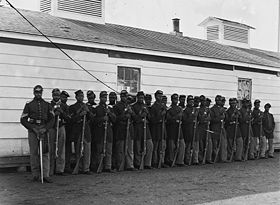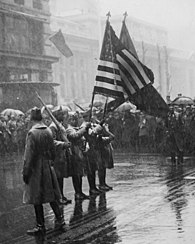United States Colored Troops: Difference between revisions
Tag: references removed |
|||
| Line 10: | Line 10: | ||
USCT regiments were led by white officers and rank advancement was limited for black soldiers. The Supervisory Committee for Recruiting Colored Regiments in Philadelphia opened a Free Military Academy for Applicants for the Command of Colored Troops at the end of 1863.<ref>Cornish, ''The Sable Arm'', p. 218.</ref> For a time, black soldiers received less pay than their white counterparts.<ref>McPherson, ''The Negro's Civil War'', Chapter XIV, "The Struggle for Equal Pay," pp. 193-203.</ref> Notable members of USCT regiments included [[Martin Delany|Martin Robinson Delany]], and the sons of [[Frederick Douglass]]. Soldiers who fought in the [[Army of the James]] were eligible for the [[Butler Medal]], commissioned by that army's commander, [[Major General|Maj. Gen.]] [[Benjamin Franklin Butler (politician)|Benjamin Butler]]. |
USCT regiments were led by white officers and rank advancement was limited for black soldiers. The Supervisory Committee for Recruiting Colored Regiments in Philadelphia opened a Free Military Academy for Applicants for the Command of Colored Troops at the end of 1863.<ref>Cornish, ''The Sable Arm'', p. 218.</ref> For a time, black soldiers received less pay than their white counterparts.<ref>McPherson, ''The Negro's Civil War'', Chapter XIV, "The Struggle for Equal Pay," pp. 193-203.</ref> Notable members of USCT regiments included [[Martin Delany|Martin Robinson Delany]], and the sons of [[Frederick Douglass]]. Soldiers who fought in the [[Army of the James]] were eligible for the [[Butler Medal]], commissioned by that army's commander, [[Major General|Maj. Gen.]] [[Benjamin Franklin Butler (politician)|Benjamin Butler]]. |
||
===Notable actions=== |
|||
USCT regiments fought in all theaters of the war, but mainly served as garrison troops in rear areas. The most famous USCT action took place at the [[Battle of the Crater]] during the [[Siege of Petersburg]], where regiments of USCT suffered heavy casualties attempting to break through [[Confederate States Army|Confederate]] lines. Other notable engagements include [[Fort Wagner]] and the [[Battle of Nashville]]. USCT soldiers often became victims of battlefield atrocities, most notably at [[Battle of Fort Pillow|Fort Pillow]].<ref>Cornish, ''The Sable Arm'', pp. 173-180.</ref> The prisoner exchange cartel broke down over the Confederacy's position on black [[prisoner of war|prisoners of war]]. Confederate law stated that blacks captured in uniform be tried as slave insurrectionists in civil courts—a capital offense. Although this rarely, if ever, happened, it became a stumbling block for prisoner exchange. USCT soldiers were among the first Union forces to enter [[Richmond, Virginia]], after its fall in April 1865. The 41st USCT regiment was present at the surrender of the [[Army of Northern Virginia]] at [[Appomattox Court House National Historical Park|Appomattox]]. Following the war, USCT regiments served as occupation troops in former Confederate states. |
|||
If your not going to allow ALL sides of story... |
|||
===Awards=== |
===Awards=== |
||
Revision as of 19:47, 21 April 2010

The United States Colored Troops (USCT) were regiments of the United States Army during the American Civil War that were composed of African-American soldiers. The men of the USCT were the forerunners of the famous Buffalo Soldiers.
History
The U.S. Congress passed a confiscation act in July 1862 that freed slaves of owners in rebellion against the United States, and a militia act that empowered the President to use freed slaves in any capacity in the army. President Abraham Lincoln, however, was concerned with public opinion in the four border states that remained in the Union, as well as with northern Democrats who supported the war. Lincoln opposed early efforts to recruit black soldiers, even though he accepted their use as laborers. Union Army setbacks in battles over the summer of 1862 forced Lincoln into the more drastic response of emancipating all slaves in states at war with the Union. In September 1862 Lincoln issued his preliminary proclamation that all slaves in rebellious states would be free as of January 1. Recruitment of colored regiments began in full force following the Emancipation Proclamation of January 1863.[1]
The United States War Department issued General Order Number 143 on May 22, 1863, establishing a "Bureau of Colored Troops" to facilitate the recruitment of African-American soldiers to fight for the Union Army.[2] Regiments, including infantry, cavalry, light artillery, and heavy artillery units, were recruited from all states of the Union and became known as the United States Colored Troops (USCT). Approximately 175 regiments of over 178,000 free blacks and freed slaves served during the last two years of the war, and bolstered the Union war effort at a critical time. By war's end, the USCT were approximately a tenth of all Union troops. There were 2,751 USCT combat casualties during the war, and 68,178 losses from all causes.[3]

USCT regiments were led by white officers and rank advancement was limited for black soldiers. The Supervisory Committee for Recruiting Colored Regiments in Philadelphia opened a Free Military Academy for Applicants for the Command of Colored Troops at the end of 1863.[4] For a time, black soldiers received less pay than their white counterparts.[5] Notable members of USCT regiments included Martin Robinson Delany, and the sons of Frederick Douglass. Soldiers who fought in the Army of the James were eligible for the Butler Medal, commissioned by that army's commander, Maj. Gen. Benjamin Butler.
If your not going to allow ALL sides of story...
Awards
Sergeant Major Christian Fleetwood was awarded the Medal of Honor for his actions with the 4th USCT in the Battle of Chaffin's Farm in Virginia. Fleetwood took up the regimental colors after 11 other USCT soldiers had been shot down while carrying them forward. Many USCT soldiers won some of the nation's highest awards. Sergeant William Harvey Carney of the 54th Massachusetts was another African American Medal of Honor recipient.
Postbellum and legacy

After the war many USCT veterans struggled for recognition and had difficulty obtaining the pensions rightful to them. The Federal government did not address the inequality until 1890 and many of the veterans did not receive service and disability pensions until the early 1900s. The history of the USCT's wartime contribution was kept alive within the black community by historians such as W. E. B. Du Bois and the subject has enjoyed a recent surge in literature.
The motion picture Glory, starring Denzel Washington, Morgan Freeman and Matthew Broderick, depicted the African-American soldiers of the 54th Massachusetts Regiment during their training and several battles, including the second assault on Fort Wagner on July 18, 1863.[6]
A national celebration in commemoration of the service of the United States Colored Troops was held in September 1996. A national museum is located at 1200 U Street, NW, Washington, D.C. The African American Civil War Memorial, featuring Spirit of Freedom by sculptor Ed Hamilton, is located nearby, at the corner of Vermont Avenue and U Street, NW.
Numbers of Union "Colored Troops" by state, North and South
| North | Number | South | Number |
|---|---|---|---|
| Connecticut | 1,764 | Alabama | 4,969 |
| Colorado Territory | 95 | Arkansas | 5,526 |
| Delaware | 954 | Florida | 1,044 |
| District of Columbia | 3,269 | Georgia | 3,486 |
| Illinois | 1,811 | Louisiana | 24,502 |
| Indiana | 1,597 | Mississippi | 17,869 |
| Iowa | 440 | North Carolina | 5,035 |
| Kansas | 2,080 | South Carolina | 5,462 |
| Kentucky | 23,703 | Tennessee | 20,133 |
| Maine | 104 | Texas | 47 |
| Maryland | 8,718 | Virginia | 5,723 |
| Massachusetts | 3,966 | ||
| Michigan | 1,387 | Total from the South | 93,796 |
| Minnesota | 104 | ||
| Missouri | 8,344 | At large | 733 |
| New Hampshire | 125 | Not accounted for | 5,083 |
| New Jersey | 1,185 | ||
| New York | 4,125 | ||
| Ohio | 5,092 | ||
| Pennsylvania | 8,612 | ||
| Rhode Island | 1,837 | ||
| Vermont | 120 | ||
| West Virginia | 196 | ||
| Wisconsin | 155 | ||
| Total from the North | 79,283 | ||
| Total | 178,895 |
See also
- List of United States Colored Troops Civil War Units
- Marching Song of the First Arkansas
- Fort Pocahontas
- 54th Massachusetts Volunteer Infantry
- 92nd Infantry Division (United States)
- 93d Infantry Division (United States)
- 366th Infantry Regiment (United States)
- Tuskegee Airmen
- 761st Tank Battalion (United States)
Notes
- ^ Cornish, The Sable Arm, pp. 29-111.
- ^ Cornish, The Sable Arm, p. 130.
- ^ Cornish, The Sable Arm, p. 288; McPherson, The Negro's Civil War, p. 237.
- ^ Cornish, The Sable Arm, p. 218.
- ^ McPherson, The Negro's Civil War, Chapter XIV, "The Struggle for Equal Pay," pp. 193-203.
- ^ See the film review by historian James M. McPherson, “The ‘Glory’ Story,” The New Republic, January 8 & 15, 1990, pp. 22-27.
References
- Dudley Taylor Cornish, The Sable Arm: Negro Troops in the Union Army, 1861-1865 (1956; New York: W.W. Norton, 1965).
- James M. McPherson, The Negro's Civil War: How American Negroes Felt and Acted During the War for the Union (New York: Pantheon Books, 1965).
External links
- United States Colored Troops in the Civil War
- United States Colored Troops US Army
- African Americans in the U.S. Army
- Mr. Lincoln and Freedom: Black Soldiers
- 1863 Picture and News Report on the First Colored Regiment in the US
- African American Civil War Memorial and Museum
- 5th United States Colored Infantry [1]
- 8th USCT
- 35th USCT (previously the 1st North Carolina Colored Volunteers)
- 54th Massachusetts
- ."Inside Buffalo" a 2010 Award winning film documentary about the 92nd Division nicknamed "Buffalo Soldiers" which fought in Italy during Second World War

